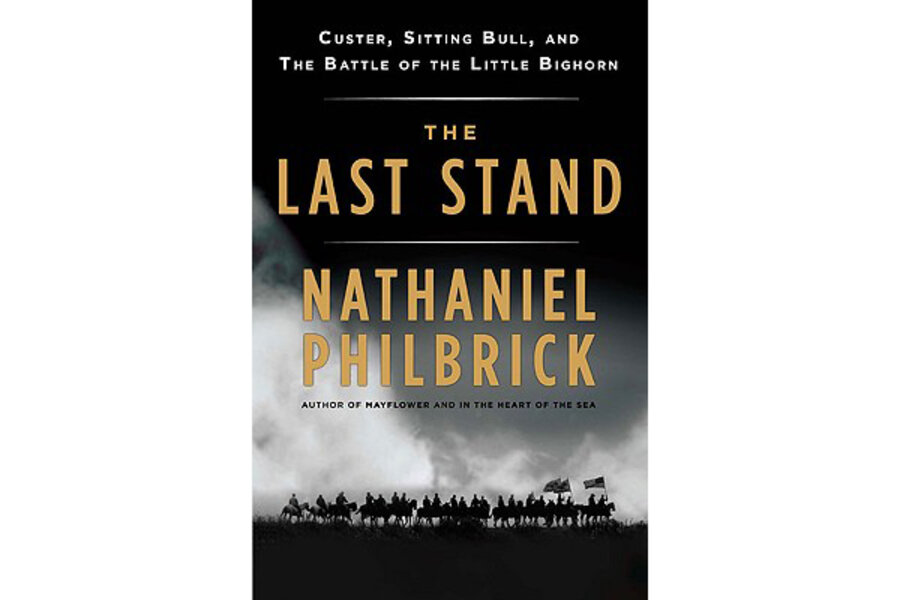The Last Stand
Loading...
Like a long-haired rock star prancing about the stage in super-tight jeans, Gen. George Custer eschewed comfort for style in Davey Crocket-style buckskin pants and shirts that shrank in the sun, even though light and fast-drying cotton was by then a commonly worn cloth.
“His uniform was spotless and fitted him like the skin on a sausage,” one officer recalls in Nathaniel Philbrick’s eighth and newest book, The Last Stand: Custer, Sitting Bull, and the Battle of the Little Big Horn. It’s a typical example of the great detail offered in this story of a passionate, ambitious man whose flamboyant, irrational style earned him fame, enemies, and death at age 36.
Philbrick is a meticulous historian. His previous book, “Mayflower,” was a finalist for the 2007 Pulitzer Prize in History. An otherwise upbeat Monitor review of “Mayflower” qualified that, “Philbrick spends too little time on the big picture and too much on arcane detail, making for many dry passages.” Unfortunately, that problem continues in this book. While offering interesting tidbits, tedious minutiae and irrelevant details bog down what could be a riveting narrative.
Meanwhile, interesting asides receive little attention or elaboration. Philbrick mentions, for example, that Sitting Bull, after defeating Custer at the Battle of Little Bighorn, went on tour with Buffalo Bill’s Wild West Show, but never explains why the great chief subjected himself to such silliness. Moreover, Philbrick buries his important hypothesis – that Custer is a scapegoat for the 1876 military fiasco that granted him immortality in US history books.
At age 23, Custer had become one of America’s youngest-ever generals, helping Abraham Lincoln’s troops win the battles of Bull Run, Gettysburg, and Appomattox. These successes made him a popular political figure (he stumped for President Andrew Johnson) with sights set on the White House. But he was a bitter rival to Ulysses S. Grant. Custer was the only West Point cadet to match Grant’s record in riding and jumping, a fact that Custer seemed eager to flaunt when he bolted in front of Grant during the Union’s victory procession into Washington, D.C.
Animosity bubbled up again when Custer implicated both Grant’s secretary of war and brother in a corruption scheme concerning Army forts, though Custer’s claims were speculative. Incensed, Grant tried to sideline Custer by pulling him from fighting in the West. This would have saved Custer’s life had not Custer himself insisted on returning to Montana to storm the village of 8,000 Lakota and Northern Cheyenne Indians headed by Sitting Bull, who had grown tired of America’s growing demand for land and shunned the government’s call for him to live and hunt on a reservation.
Philbrick offers several compelling theories for Custer’s humiliating loss. In part, Philbrick argues, Custer rushed into battle in an attempt to achieve a stunning military victory that would secure him the upcoming Democratic presidential nomination for the 1876 election. (Samuel Tilden, in fact, received the nomination and won the presidential election’s popular vote, but lost in the Electoral College to Republican Rutherford B. Hayes.) Custer also acted on orders from his direct supervisor, Brig. Gen. Alfred Terry, whom Philbrick argues is the real cause for Custer’s loss. It was General Terry who ordered Custer to launch the fight against Sitting Bull without waiting for reinforcements if the opportunity presented itself. Terry’s place in history deserves more attention in Philbrick’s book.
Despite this oversight, Philbrick elucidates the series of mistakes that crippled Custer: his soldiers’ rudimentary horsemanship; his refusal to believe his men were observed by Lakota scouts; his unfamiliarity with a terrain of “badlandlike crevices and ravines”; his decision to attack despite being outnumbered 3 to 1; his dehydrated soldiers drinking whiskey during the fight; his alienation of generals who in turn failed to come to his aid; and his second-in-command, Gen. Marcus Reno, who gave up the advantage of being on horse and instead attacked on foot. Yet Philbrick is also careful to point out that none of those factors had prevented Custer from winning previous battles.
It’s easy to pin the blame on Custer, however. He exaggerated and boasted to the point of lying. His autobiography “My Life on the Plains” was ridiculed by a fellow officer as My Lie on the Plains. He desecrated burial grounds and raped Indian women. He womanized and had affairs. He killed innocents, including women and children and tribal leaders who were for peace. Even before the Battle of the Little Big Horn, Sitting Bull told his nephew, One Bull, to ride out and offer peace. Custer’s men shot at him.
Despite everything Custer did wrong, Philbrick argues, he could still have won the battle with a little more luck. “Hindsight makes Custer look like an egomaniacal fool. But as Sitting Bull, Runs the Enemy, and many other Lakota and Cheyenne realized that day, he came frighteningly close to winning the most spectacular victory of his career” – and potentially the White House.
Philbrick says he first learned about Custer in the movies, and as I read the book I remembered this film reference to Custer in The Royal Tenenbaums: “Well, everyone knows Custer died at Little Bighorn. What this book presupposes is... maybe he didn’t?” It’s a hilarious line (said by Owen Wilson’s character, an attention-hungry author), in part because of the absurdity of the notion of Custer not dying at Little Bighorn.
But it’s also true. Custer’s death made him immortal – a man reincarnated in numerous plays, movies, and even video games. Philbrick says that Custer’s persona morphed with the times, from a “noble hero” during the World War II era to a “deranged maniac” during the Vietnam War era. Philbrick’s own book suggests that today, in the Iraq war era, Custer’s persona is that of a flashy and divisive cowboy whose persona obscures those who really lost the battle on the Little Big Horn.
Stephen Kurczy is a Monitor correspondent.






